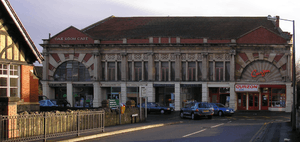Curzon Community Cinema, Clevedon

The Curzon Community Cinema, in Clevedon, North Somerset, England, is one of the oldest continually running purpose-built cinemas in the world.
Opened on 20 April 1912 by Victor Cox, the original building had 200 seats and the first show raised funds for the survivors and relatives of those killed earlier in the month on the RMS Titanic.[1] Its first projector was gas powered, but in subsequent years the building was improved with the addition of extra seating (bringing the total number of seats to 389), and was the first public building in the town to have electricity, which also saw the projector upgraded to run on electric.[2]
Between 1920 and 1922 a new cinema was built on the site (without interruption to the nightly programme of films). The building, still in use to this day, has a row of shops along the front, the Oak Room Cafe above, and facilities for stage shows. The cinema was the site of Clevedon's only fatality due to enemy action in the Second World War, when a soldier standing in the cinema doorway was killed by a bomb, damage from which is still visible on the exterior.[1] Muriel Williams, who was in the cinema when it was bombed, recalls the air raid warning flashing on the screen on the night it was bombed in the Curzon Memories App.[3] The App also includes memories from Julia Elton (daughter of documentarian Sir Arthur Elton, who remembers her grandmother frequenting the Oak Room Cafe and rephotography of archive photos of the cinema through the ages.
In 1945 the cinema (previously known as "The Picture House") was sold and changed its name to the "Maxime".[2] Another change of ownership in 1953 brought its current name. After years of decline, the building was greatly altered during the late sixties and early seventies: the box fronts, along with the organ, were removed and the openings 'bricked-up', the balcony was closed, the suspended false ceiling installed, and the projection room returned to its original position at the rear of the stalls.[4]
Never hugely profitable, the cinema was taken into administrative receivership in 1995, and after a campaign to save the cinema spearheaded by Jon Webber, it was bought by Clevedon Community Centre for the Arts, a registered charity, which continues to run it. Patrons include Sir Charles Elton (son of the notable documentary director Sir Arthur Elton), Aardman Animations founders David Sproxton and Peter Lord, directors Nick Park and Terry Gilliam, and actors Tony Robinson and Alan Rickman.[5]
In 2009 the Curzon Cinema successfully passed the first round in its bid to the Heritage Lottery Fund (HLF) and was awarded £31,700 to help develop a more detailed bid for second phase of the awards process.[6] A subsequent Stage II award of £321,900 in 2010 allowed the cinema to complete the first stage of restoration, with some repairs made to the roof, a new exhibition and lounge bar installed, and the Curzon Collection of Heritage Cinema Technology being relocated to the former Coach House adjoining the building.[7] The foyer, stairway and gallery have been transformed with film posters, memorabilia and a dressing up box with fashions worn by film stars through the ages. An illustrated timeline tracks Curzon’s own story along with key dates from wider cinema and world history. There is an also an area to see heritage projectors in action, dating back to 1906 and examine strips of film.
In 2012 the Curzon Cinema reached the final for Best Heritage Project of the National Lottery Awards.[8] Curzon Director Gareth Negus said: “Restoring the Curzon has always been about more than repairing the building, we wanted to open up the heritage of the Curzon to our visitors; including not only the physical building but its social history, and what it has meant to the people of Clevedon over the past century. Even some of our regular customers were unaware until now that there is more to the Curzon than the box office and the auditorium”.[8] The funding has enabled key areas of the cinema to be repaired and refurbished to ensure it maintains its place in the heart of the community. It has also meant that young people are able to get involved in a number of learning activities or the cinema’s film club with the support of the Education Office, Cathy Poole.[9]
The Curzon celebrated its centenary on 20 April 2012, with a weekend of celebrations.[10] Run by charitable trust, the Curzon is now seeking to raise funds for the next phase of its restoration, including the Balcony.[11]
References
- ↑ 1.0 1.1 "| | This is". Thisisbristol.co.uk. Retrieved 2009-04-30.
- ↑ 2.0 2.1 "Bristol — Coast — Curzon cinema". BBC. 2005-06-21. Retrieved 2009-04-30.
- ↑ "The Curzon Community Cinema, Clevedon: History". curzon.org.uk. Retrieved 10 September 2012.
- ↑ Thornton, Maurice (2005). The Everlasting Picture Show. Clevedon: Curzon-Clevedon Community Centre for the Arts. p. 160. ISBN 978-0-9549962-0-8.
- ↑ "The Curzon Community Cinema, Clevedon: Patrons & Supporters". Curzon.org.uk. Retrieved 2009-04-30.
- ↑ "The Curzon Community Cinema, Clevedon: Home Page". Curzon.org.uk. Retrieved 2009-04-30.
- ↑ "The Curzon Community Cinema, Clevedon: The Curzon Collection of Cinema Heritage Technology". Curzon.org.uk. Retrieved 9 June 2012.
- ↑ 8.0 8.1 "Curzon in final for Best Heritage Project at National Lottery Awards". lotterygoodcauses.org.uk. Retrieved 11 September 2012.
- ↑ "The Curzon Community Cinema, Clevedon: Learning". curzon.org.uk.
- ↑ "The Curzon Community Cinema, Clevedon: Centenary Weekend". curzon.org.uk. Retrieved 10 September 2012.
- ↑ "The Curzon Community Cinema, Clevedon: Fundraising". curzon.org.uk.
External links
- The Curzon Community Cinema, Clevedon: Official Website
- Curzon Community Cinema, Clevedon in the Theatres Trust database
Coordinates: 51°26′08.66″N 2°51′18.08″W / 51.4357389°N 2.8550222°W